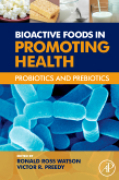
What is a dietary supplement? Congress defined the term 'dietary supplement' in the Dietary Supplement Health and Education Act (DSHEA) of 1994. A dietary supplement is a product taken by mouth that contains a 'dietary ingredient' intended to supplement the diet. The 'dietary ingredients' in these products mayinclude: vitamins, minerals, herbs or other botanicals, amino acids, and substances such as enzymes, organ tissues, glandulars, and metabolites. Dietary supplements can also be extracts or concentrates, and may be found in many formssuch as tablets, capsules, softgels, gelcaps, liquids, or powders...DSHEA places dietary supplements in a special category under the general umbrella of 'foods', not drugs, and requires that every supplement be labeled a dietary supplement. Probiotics and prebiotics are components present in foods, or that canbe incorporated into foods, which yield health benefits related to their interactions with the gastrointestinal tract (GI). Probiotic microorganisms can befound in both supplement form and as components of foods and beverages. Thesebacteria and yeasts have been used for thousands of years to ferment foods. Certain yogurts and other cultured dairy products contain such helpful bacteria, particularly specific strains of Bifidobacteria and Lactobacilli. Not all bacteria present in fermented milk products or yogurt have a probiotic effect. For this reason, in order to consider a Lactobacillus or Bifidobacterium a probiotic, the specific strains selected must exert a clinically established health benefit. Prebiotics are found naturally in many foods, and can also be isolated from plants (e.g., chicory root) or synthesized (e.g., enzymatically, fromsucrose). In order for a food ingredient to be classified as a prebiotic, it has to be demonstrated, that it: is not broken down in the stomach or absorbedin the GI tract; is fermented by the gastrointestinal microflora; and, most importantly, selectively stimulates the growth and/or activity of intestinal bacteria associated with health and wellbeing. Probiotic bacteria taken togetherwith prebiotics that support their growth are called 'synbiotics'. Both work together in a synergistic way more efficiently promoting the probiotics' benefits. International Food Information Council Foundation provides information onProbiotics and Prebiotics found in the foods we eat. It includes chart examples of Probiotics and Prebiotics as well as class/component source. Potential Benefit of this foods are as mentioned below: Probiotics - certain species and strains of Lactobacilli, Bifidobacteria, Yeast Certain yogurts, other cultureddairy products, and non-dairy applications: may improve gastrointestinal health and systemic immunity. Prebiotics - Inulin, Fructo-oligosaccharides (FOS), Polydextrose, Arabinogalactan, Polyols' lactulose, lactitol Whole grains, onions, bananas, garlic, honey, leeks, artichokes, fortified foods and beverages, dietary supplements and other food applications - may improve gastrointestinalhealth; and may also improve calcium absorption. This title includes chart adapted from International Food Information Council Foundation: Media Guide on Food Safety and Nutrition: 2004-2006. These examples are not an all-inclusive list. Probiotics are now a multi-billion-dollar, dietary supplement business which is built upon extremely little research data. In order to follow the 1994 ruling, the U.S. Food and Drug Administration with the support of Congress is currently pushing this industry to base its claims and products on scientific research. Research as shown that dietary habits need to be altered for most people whether for continued or improved good health. The conclusions and recommendations from the various chapters in this book will provide a basis for those important factors of change by industry with new uses. Animal studies and early clinical ones will lead to new uses and studies. Particularly the cutting edge experimental and clinical studies from Europe will provide novel approaches to clinical uses through their innovative new studies. "Bioactive Foods in Health Promotion: Probiotics and Prebiotics" brings together experts working on the different aspects of supplementation, foods, and bacterial preparations,in health promotion and disease prevention, to provide current scientific information, as well as providing a framework upon which to build clinical disease treatment studies. Since common dietary bacterial preparations are over-the-counter and readily available, this book will be useful to the growing nutrition, food science, and natural product community that will use it as a resourcein identifying dietary behavioral modifications in pursuit of improved healthas well as for treatment of specific disease, as it focuses on the growing body of knowledge of the role of various bacteria in reducing disease risk and disease. Features and their benefits of this book are mentioned below: feature - heavy emphasis on clinical applications (benefits and/or lack thereof) as well as future biomedical therapeutic uses identified in animal model studies. Benefits - focused on therapies and data supporting them for application in clinical medicine as complementary and alternative medicines. Feature - key insights into gut flora and the potential health benefits thereof. Benefit - healthscientists and nutritionists will use this information to map out key areas of research. Food scientists will use it in product development. Feature - information on pre-and probiotics as important sources of micro-and macronutrients. Benefit - aids in the development of methods of bio-modification of dietary plant molecules for health promotion. Features and their benefits of this bookalso include: feature - coverage of a broad range of bacterial constituents. Benefits - nutritionists will use the information to identify which of these constituents should be used as dietary supplements based on health status of anindividual. Feature - science-based information on the health promoting characteristics of pre-and probiotics. Benefits - provides defense of food selections for individual consumption based on health needs and current status. Feature - diverse international authoring team experienced in studying prebiotics and probiotics for medical practice. Benefits - unusually broad range of experiences and newly completed clinical and animal studies provides extended access to latest information.
- ISBN: 978-0-12-374938-3
- Editorial: Academic Press
- Encuadernacion: Cartoné
- Páginas: 638
- Fecha Publicación: 01/04/2010
- Nº Volúmenes: 1
- Idioma: Inglés
